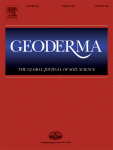Ver ítem
- xmlui.general.dspace_homeCentros Regionales y EEAsCentro Regional Buenos Aires SurEEA Cuenca del SaladoArtículos científicosxmlui.ArtifactBrowser.ItemViewer.trail
- Inicio
- Centros Regionales y EEAs
- Centro Regional Buenos Aires Sur
- EEA Cuenca del Salado
- Artículos científicos
- Ver ítem
Hydraulic conductivity and pore connectivity. Effects of conventional and no-till systems determined using a simple laboratory device
Resumen
Soil hydraulic conductivity is a property that describes how easily water can move through a porous space and its determination is important because it controls many soil hydrological processes. The objectives of this work were: i - to assess the suitability of lab tension mini-infiltrometry to measure hydraulic conductivity, by comparing with field tension disc infiltrometer data; and ii - to assess the effect of different tillage practices on hydraulic
[ver mas...]
Soil hydraulic conductivity is a property that describes how easily water can move through a porous space and its determination is important because it controls many soil hydrological processes. The objectives of this work were: i - to assess the suitability of lab tension mini-infiltrometry to measure hydraulic conductivity, by comparing with field tension disc infiltrometer data; and ii - to assess the effect of different tillage practices on hydraulic conductivity values and pore network in three different soils from Argentinean Pampas Region. Additionally, three analytical approaches to obtain K from mini-infiltrometry data were compared. Field infiltration with tension disc infiltrometer (TI) and laboratory infiltration with a proposed mini-infiltrometer (MI) were conducted in three different textured soils of Argentinian Pampas Region (loam, silty loam and sandy loam) in long-term experiments under no-tillage (NT) and conventional tillage (CT). Hydraulic conductivity (K) at different tensions (h) (6, 3 and 0 cm), namely K6, K3 and K0, and soil pore connectivity were estimated. There was no significant difference between K (h) values obtained from TI and MI, ranging between 0.47 and 2.36 cm h−1 and 0.52 and 1.77 and cm h−1, respectively. We concluded that NT reduces soil hydraulic conductivity, affecting soil pore connectivity, especially in fine textured soils. CT showed higher total pore connectivity in all studied sites. The proposed laboratory mini-infiltrometry method allows determining soil hydraulic conductivity function and pore connectivity in a simple, fast and inexpensive way.
[Cerrar]

Autor
Soracco, Carlos Germán;
Villarreal, Rafael;
Melani, Esteban;
Oderiz, Juan Agustin;
Salazar, María Paz;
Otero, María Florencia;
Irizar, Alicia Beatriz;
Lozano, Luis Alberto;
Fuente
Geoderma 337 : 1236-1244 (March 2019)
Fecha
2019-03-01
Editorial
Elsevier
ISSN
0016-7061
1872-6259
1872-6259
Formato
pdf
Tipo de documento
artículo
Palabras Claves
Derechos de acceso
Restringido
 Excepto donde se diga explicitamente, este item se publica bajo la siguiente descripción: Creative Commons Attribution-NonCommercial-ShareAlike 2.5 Unported (CC BY-NC-SA 2.5)
Excepto donde se diga explicitamente, este item se publica bajo la siguiente descripción: Creative Commons Attribution-NonCommercial-ShareAlike 2.5 Unported (CC BY-NC-SA 2.5)

